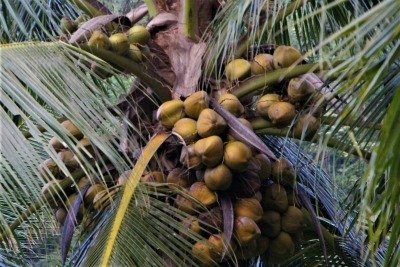This one particular coconut tree is my self-proclaimed Hall of Famer. The tree grows in my farm. Reckoned from the time the former owner acquired possession of the property, the tree is likely about 20 years old. The variety, though, is unknown.
This coconut tree is a prolific producer of medium-sized fruits, commonly called nuts, although no fertilization has ever been done. In August 2018 one bunch naturally dropped and found to contain 26 mature nuts. This was followed soon by one bunch with 24 nuts. The average was 25 per bunch.
The fruits must have started developing a year ago when there was plenty of rain. Other climatic elements and the naturally-existing soil properties must also have favored the high fruit yield.
No matter, it should not be considered an anomalous development. There are other coconut trees in this and adjacent farms but this is the only one that is consistently exceptional.
For over two years I’ve stared at this tree and admired it compared to others nearby and farther away. I have no doubt that the fruiting characteristics it shows are inherent.

Anyway, the subject of this story is its “potential yielding ability.”
For convenience, may I just refer to this coconut tree as “My Coconut Selection 1.” I have started propagating it for mass field planting. I am looking into the possibility that in due time the farm will have the option of marketing green coconut.
Note: Despite common usage, the “coconut tree” is actually a palm rather than a tree which is woody. It is a “palm” being a member of the family Palmae or Arecaceae. Likewise, the reference to the fruit of coconut as “nut” is borne out of common usage and should not be considered as technically compliant with botanical nomenclature.
Fruit Yielding Potential of this Coconut Tree is Exceptional
Yes, this palm is rather unique. At least to me. I’ve been exposed since childhood to thousands of coconuts growing in the places I stayed and elsewhere. This one palm just beat them all.
I had seen only one coconut tree growing in a home lot in General Santos City with more nuts per bunch but it was of the “Nana” type. The nuts were too small and should be considered unsuitable for copra-making or for young green coconut.
This Nana coconut should be attractive though as a source of seednuts for ornamental purposes. However, I am unaware if the tree still survives.
As to my coconut tree, it fits squarely into my master plan for the farm. I wanted to grow coconut with varied potential economic uses. These uses of coconut include copra, coconut sap or toddy, palm sugar, and also young green coconuts or “buko” or “butong.”
Uses of the young green coconut include source of coconut water as a refreshing drink, tender meat as food, buko salad, and buko halo-halo. I do enjoy all of these.
The coconut water (often called “coconut milk” in old literature) is also used as an additive in tissue culture media as source of the plant hormone cytokinin.
There’s Potential Market for Young Green Coconut
My friend Gary buys young green nuts (buko or butong) at PhP14.00 apiece regardless of size (medium to large) and sells them for a profit. He claimed that he could dispose at least 1,000 buko per day in General Santos City.
Gary has several favorite areas beside busy streets in the city where he parks his motorcycle with attached platform that converts to a sort of fruit stand with roofing. At one time he also did his selling in one school during intramurals.
Many more are engaged in the same business. Piles of green coconuts are a daily scene beside city streets. Some food establishments serve buko halo-halo.
Comparing the Gross Market Potential of Green Coconut with Other Products
We should know if there is any basis for at least exploring the idea of marketing young green coconut in the future. To do this, we need quantified data on sale and compare it with whole dehusked nuts and with copra.
Here’s the hypothetical problem I posted on social media with my coconut tree as subject:
If you have a hectare of such coconut variety with 100 trees (hills) and you sell all young green coconuts at wholesale price of PhP10.00 per nut, how much will your gross sale be in 1 month? In 3 months? In 1 year? Assume that each tree produces 1 bunch with 15 nuts per month.
Compare with whole dehusked nuts and with copra.
The usual interval for harvesting of coconut trees for mature nuts intended for copra in SOCSARGEN is 3 months.
According to a reliable source, the current buying price at present for dehusked nuts delivered to the processing plant is about PhP5.00 per kilogram. For ripe copra the maximum is PhP17.00/kg.
Now let’s do the math.
For number of nuts in 1 month
15 nuts/bunch X 1 bunch/tree/month = 15 nuts/tree/month
15 nuts/tree/month X 100 trees/ha = 1,500 nuts/ha/month
For number of nuts in 3 months or 1 quarter
15 nuts/bunch X 3 bunches/quarter = 45 nuts/tree/quarter
45 nuts/tree/quarter X 100 trees/ha = 4,500 nuts/ha/quarter
For number of nuts in 4 quarters or 1 year
45 nuts/tree/quarter X 4 quarters/year = 180 nuts/tree/year
180 nuts/tree/year X 100 tree/ha = 18,000 nuts/ha/year
Calculated gross sale in 1 month
1,500 nuts/ha/month X PhP10.00/nut = PhP15,000.00/ha/month
Calculated gross sale in 3 months or 1 quarter
4,500 nuts/ha/quarter X PhP10.00/nut = PhP45,000.00/ha/quarter
Calculated gross sale in 4 quarters or 1 year
18,000 nuts/ha/year X PhP10.00/nut = PhP180,000.00/ha/year
Do you believe this? Compare with coconut trees harvested for whole nuts and also for copra. Consider the costs too.
Starting a Farm <<< >>> Green Coconuts
